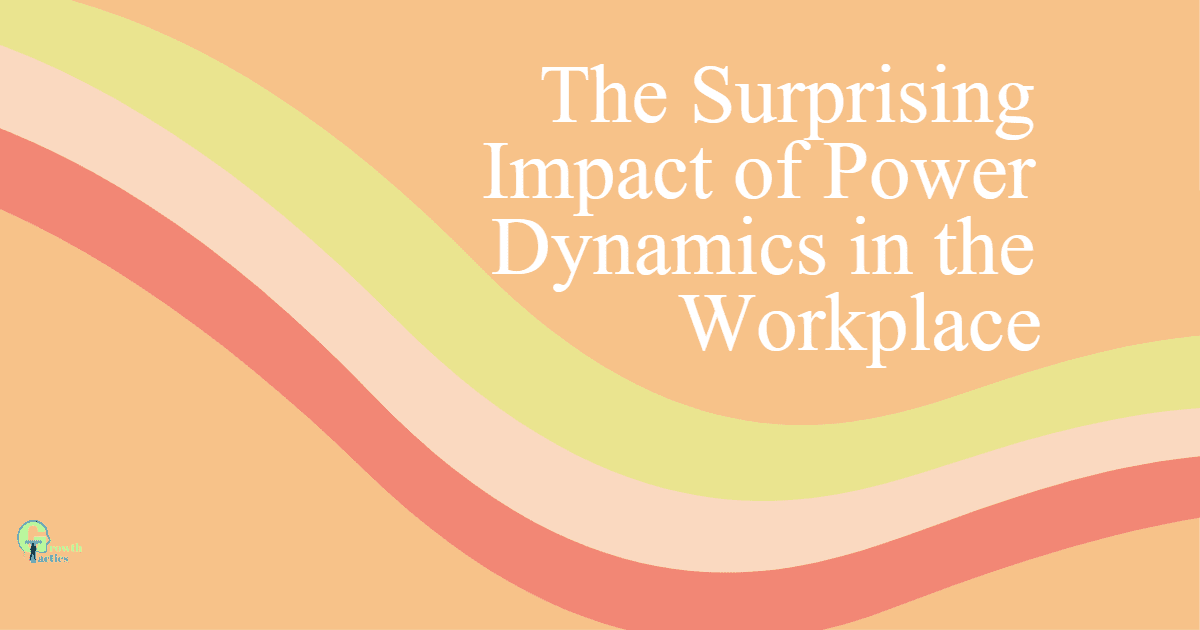Power dynamics in the workplace play a crucial role in shaping the overall work environment, relationships, and individual experiences. Understanding and navigating these power dynamics can significantly impact productivity, employee engagement, and overall organizational success.
Moreover, power dynamics can also have unexpected consequences, both positive and negative, on individuals and teams. In this article, we will explore the surprising impact of power dynamics in the workplace and delve into different types of power, their effects, and strategies for fostering healthy and empowering work environments.
Gain insights into how power dynamics can shape your workplace and learn how to navigate them effectively for better professional outcomes.

Types of Power in the Workplace
In the workplace, power can manifest in various forms, each playing a distinct role in shaping relationships and influencing dynamics. Understanding these types of power is essential for comprehending the complexities of power dynamics in the workplace. Let’s explore some of the most common types of power:
Coercive Power: A Closer Look at its Impact and Consequences
Coercive power is based on the ability to punish or penalize others for non-compliance. Individuals who possess coercive power can use fear, threats, or disciplinary actions to assert control over others. However, relying solely on coercive power can often lead to negative consequences such as diminished morale, resistance, and strained relationships within the workplace.
Legitimate Power: Examining Authority and Its Effects on Workplace Dynamics
Legitimate power is derived from an individual’s authority and formal position within an organization. This type of power is bestowed upon individuals based on their roles, responsibilities, and hierarchical positions. People who hold legitimate power have the authority to make decisions, allocate resources, and enforce policies. While legitimate power plays a crucial role in maintaining order and structure within the workplace, it can also potentially lead to power imbalances and issues of authority abuse if not wielded responsibly.
Referent Power: Understanding the Influence of Likeability and Charisma
Referent power is based on an individual’s likability, charisma, and ability to build strong interpersonal connections. People with referent power are admired, respected, and often sought after for guidance and support. They possess influence due to their ability to inspire trust and loyalty among their colleagues. Referent power is a positive form of power that fosters collaboration, teamwork, and positive relationships in the workplace.
Expert Power: The Role of Knowledge and Skills in Power Dynamics
Expert power stems from an individual’s knowledge, skills, and expertise in a particular field. People with expert power are highly competent and have a deep understanding of their area of specialization. Others in the workplace perceive them as credible and rely on them for guidance, advice, and decision-making. Expert power is based on respect earned through demonstrated competence and can greatly influence workplace dynamics.
Reward Power: How Incentives and Recognition Shape Power Relationships
Reward power is derived from the ability to provide rewards, incentives, and recognition to others in exchange for compliance or successful performance. Individuals who possess reward power can motivate and influence others by offering promotions, bonuses, praise, or other desirable incentives. While reward power can be a positive force in the workplace, it is important to ensure that it is used fairly and transparently to avoid fostering unhealthy competition or favoritism.
Understanding the different types of power in the workplace is crucial for recognizing the dynamics at play and their potential impact on relationships, decision-making, and overall organizational culture. By comprehending the nuances of these power dynamics, individuals can navigate them more effectively and foster a healthier, more balanced work environment.
Common Power Dynamics in the Workplace
Power dynamics in the workplace can manifest in various ways, impacting interactions, decision-making, and overall work culture. Being aware of these common power dynamics is essential in navigating them effectively. Here are some prevalent power dynamics often seen in the workplace:
Uncovering Power Imbalances: Examining Power Struggles and Hierarchies
Power imbalances occur when there is an unequal distribution of power among individuals or groups within an organization. This can lead to power struggles, where those with more power exert control over others. Hierarchies within organizations can contribute to power imbalances, with individuals at higher levels having more power and influence. Recognizing and addressing power imbalances is crucial for creating a fair and inclusive work environment.
Navigating the Politics of Power: Strategies for Success in Competitive Environments
Office politics, characterized by subtle power plays and maneuvering, are common in competitive workplace settings. In such environments, individuals may strategically use their power and influence to gain advantages, recognition, or promotions. Navigating office politics requires understanding the power dynamics at play, building relationships, and maintaining professionalism while staying true to one’s values.
Understanding Power Dynamics in Team Settings: Collaboration vs. Power Struggles
Power dynamics within teams can significantly influence their productivity and cohesion. In collaborative team settings, power is distributed evenly, and members work together based on shared goals and mutual respect. However, power struggles can emerge if some team members try to exert dominance or control over others. Recognizing and addressing power dynamics within teams is essential for fostering effective collaboration and maintaining a positive work environment.
The Impact of Power Dynamics on Decision-Making: Who Holds the Real Influence?
Power dynamics can heavily influence decision-making processes within organizations. Individuals with more power and influence often have a greater say in shaping decisions, potentially leading to the marginalization of those with less power. Understanding the impact of power on decision-making is crucial to ensure a fair and inclusive process where multiple perspectives are considered.
Healthy Power Dynamics: Balancing Cooperation and Healthy Competition
Healthy power dynamics foster a balance between cooperation and healthy competition. In such environments, power is shared, and individuals collaborate, support one another, and celebrate each other’s successes. Healthy power dynamics encourage open communication, respect for different viewpoints, and nurturing a work culture where everyone feels valued and respected.
Recognizing and understanding these common power dynamics in the workplace is essential for creating a positive and inclusive work environment. By actively addressing power imbalances, navigating office politics tactfully, fostering collaboration within teams, ensuring fair decision-making processes, and promoting healthy power dynamics, organizations can cultivate a supportive and empowering workplace for all employees.

The Balance of Power: Ethics and Implications
Power dynamics in the workplace have significant ethical implications that require careful consideration. When power is misused or imbalances exist, it can have detrimental effects on employee morale, engagement, and the overall work environment. Here are some key considerations regarding the ethics and implications of power dynamics:
Ethical Considerations in Power Dynamics: How Power Can be Misused
With power comes responsibility, and ethical considerations play a vital role in determining how power is used. Power can be misused when individuals prioritize their own interests over the well-being of others. This can involve favoritism, discriminatory practices, withholding information, or manipulating others for personal gain. It is essential for individuals in positions of power to uphold ethical standards and treat others with fairness, respect, and integrity.
Assessing the Impact of Power Imbalances on Employee Morale and Engagement
Power imbalances can negatively impact employee morale and engagement. When some individuals have more power and influence than others, it can create a sense of unfairness, resentment, and demotivation among those with less power. Employees in subordinate positions may feel disempowered, undervalued, or voiceless, leading to decreased engagement and productivity. Understanding and addressing power imbalances is key to fostering a positive work environment that promotes employee well-being.
Addressing Power Inequality: Creating a Fair and Inclusive Work Environment
Addressing power inequality requires a commitment to creating a fair and inclusive work environment. Organizations should strive to create a culture that values diversity, equity, and inclusion. This involves establishing policies and practices that promote equal opportunities, transparent decision-making, and a safe space for employees to voice their concerns and ideas. By addressing power inequality, organizations can enhance employee satisfaction, engagement, and overall performance.
Balancing Power: Promoting Collaborative Decision-Making
One way to mitigate power imbalances and uphold ethical standards is by promoting collaborative decision-making. This means involving employees at all levels in the decision-making process, valuing their input, and fostering open dialogue. Collaborative decision-making empowers individuals, creates a sense of ownership, and leads to better outcomes through diverse perspectives and shared commitment.
Empowering Employees: Sharing Power and Building Trust
Empowering employees is crucial in achieving a balance of power. This involves sharing power, delegating responsibilities, and providing opportunities for growth and development. Building trust is also essential, as it enables individuals to feel safe in expressing their opinions and concerns. By empowering employees, organizations can create a culture of mutual respect, trust, and shared accountability.
Striving for ethical power dynamics and addressing power imbalances is an ongoing process that requires commitment and continuous evaluation. By fostering a fair and inclusive work environment, organizations can promote employee well-being, engagement, and overall success.

Strategies for Navigating Power Dynamics
Navigating power dynamics in the workplace can be challenging, but there are strategies that individuals can employ to effectively navigate these dynamics. Here are some key strategies:
Building Personal Power: Developing Assertiveness and Self-Confidence
Building personal power is crucial in navigating power dynamics. Developing assertiveness and self-confidence enables individuals to assert their opinions and needs while respecting others. This involves setting boundaries, expressing oneself clearly, and standing up for what is right. By building personal power, individuals can navigate power dynamics with confidence and integrity.
Leveraging Social Power: The Importance of Networking and Relationship Building
Social power, derived from relationships and networks, plays a significant role in navigating power dynamics. Building strong relationships and networks within the organization helps individuals gain support, influence decisions, and have a voice. This can be achieved by actively networking, seeking mentors, and collaborating with others. Leveraging social power enhances an individual’s ability to navigate power dynamics effectively.
Enhancing Expertise and Skills: Empowering Through Knowledge and Competence
One powerful strategy for navigating power dynamics is enhancing expertise and skills. Developing deep knowledge and competence in one’s area of work establishes credibility and gives individuals a strong position. By continuously learning, staying updated on industry trends, and expanding expertise, individuals can gain respect and influence, regardless of their position in the power dynamics.
Utilizing Power Effectively: Promoting Collaboration and Empowerment
Rather than seeking power over others, individuals should aim to utilize power effectively by promoting collaboration and empowerment. This involves sharing information, involving others in decision-making, and promoting a supportive work environment. By empowering colleagues and fostering a sense of shared ownership, individuals can create a positive power dynamic that benefits the entire team or organization.
Seeking Allies and Mentors: Forming Supportive Connections
Seeking allies and mentors is another valuable strategy in navigating power dynamics. Allies can provide support, guidance, and advocacy, while mentors can offer advice and share their experiences. Developing these connections provides individuals with a support system and helps tackle power dynamics more effectively.
Continuous Self-Reflection and Growth: Adapting to Changing Power Dynamics
Lastly, continuous self-reflection and growth are essential strategies for navigating power dynamics. Individuals should regularly assess their own behavior and the power dynamics they encounter. By recognizing areas for improvement, individuals can adapt their approach, build resilience, and effectively navigate changing power dynamics over time.
By implementing these strategies, individuals can navigate power dynamics more effectively and promote a positive and inclusive work environment. It is crucial to approach power dynamics with empathy, awareness, and a commitment to ethical behavior to create a workplace where everyone can thrive.
Conclusion
Creating a positive and productive power dynamic requires a collective effort. It starts with individuals in positions of power recognizing their responsibility to use their power ethically, ensuring fairness and inclusivity.
At the same time, empowering employees through personal growth, relationship building, and collaborative decision-making can help mitigate power imbalances. By actively working towards a balance of power, organizations can cultivate an environment that promotes employee satisfaction, engagement, and success. Together, we can create workplace cultures that value and empower every individual, regardless of their position within the power dynamics.


